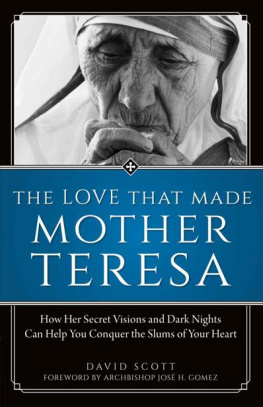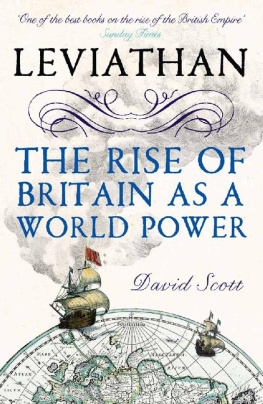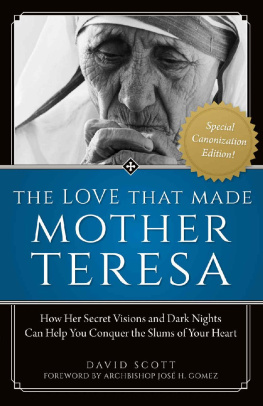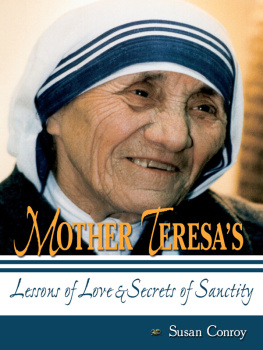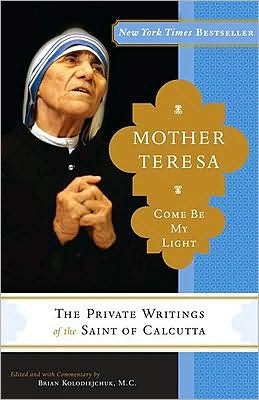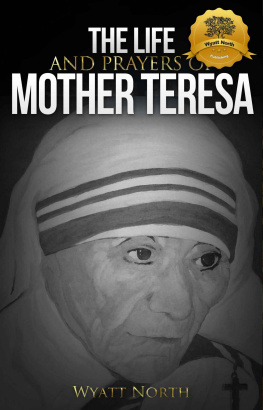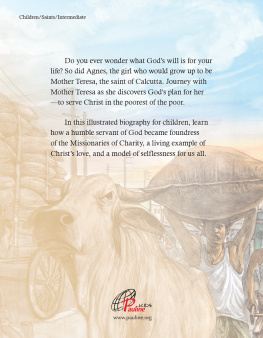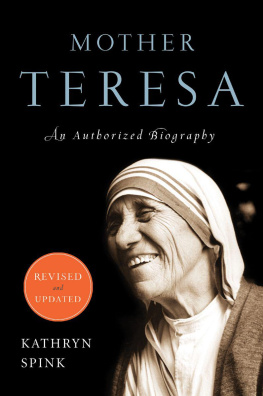David Scott
The Love That Made Mother Teresa
How Her Secret Visions and Dark Nights Can Help You Conquer the Slums of Your Heart
SOPHIA INSTITUTE PRESS
Manchester, New Hampshire
The Love That Made Mother Teresa is a revised version of A Revolution of Love: The Meaning of Mother Teresa , published by Loyola Press, Chicago, in 2005.
Copyright 2013 David Scott
Printed in the United States of America
All rights reserved
Cover design by Carolyn McKinney
On the cover : Mother Teresa Praying (U88243061) Bettmann / CORBIS
No part of this book may be reproduced, stored in a retrieval system, or transmitted in any form, or by any means, electronic, mechanical, photocopying, or otherwise, without the prior written permission of the publisher, except by a reviewer, who may quote brief passages in a review.
Sophia Institute Press
Box 5284, Manchester, NH 03108
1-800-888-9344
www.SophiaInstitute.com
Sophia Institute Press is a registered trademark of Sophia Institute.
Library of Congress Cataloging-in-Publication Data Scott, David, 1961- [Revolution of love] The love that made Mother Teresa : how her secret visions and dark nights can help you conquer the slums of your heart / David Scott. pages cm Rev. ed. of: A revolution of love : the meaning of Mother Teresa. c2005. Includes bibliographical references. ISBN 978-1-62282-200-3 (pbk. : alk. paper) eBook ISBN 978-1-622822-01-0
1. Teresa, Mother, 1910-1997. I. Title. BX4406.5.Z8S36 2014 .97 dc23 2013045740
For Jacob
Contents
Part I Part II Part III Part IV
Foreword
The Church is beautiful in her saints. One of the Church Fathers said that long ago. And its true.
The saints are living witnesses to Jesus Christ in every age and every culture. They show us what following Christ looks like in real life and how to fulfill Gods plan for our lives which is for us to become more like Jesus and become saints ourselves.
As David Scott writes in this fine little book, Blessed Mother Teresa of Calcutta was probably the most familiar Christian face of our generation. Her works of love, done for the abandoned and forsaken in a remote city in India, made hers a household name the world over.
This book represents something of a new way of writing about the saints. Its part biography, part spiritual reading of our times. There is also a strong apologetic aspect. Scott suggests that Mother Teresa is Gods response to the signs of our times a witness to the power and beauty of the gospel message in a world marked by the shadow of death and a growing indifference to God.
Mother Teresa gave up her privileged position and all her possessions to live as one of the worlds poor and forgotten and to bring them the light of Christ and the love of God. Her message to the rest of us was direct: we should seek our salvation in the God who comes to us in the poor and the outcast. We should seek Jesus at the margins of society in what she called his distressing disguise.
Always she returned to Jesus parable of the last judgment: As you did it to one of the least of these my brethren, you did it to me.
Our Holy Father Pope Francis has said that we should reread often the twenty-fifth chapter of St. Matthews Gospel, where Jesus identifies himself with the least of these the hungry and the thirsty, the naked and the sick, the prisoner and the immigrant. If you want to know what you actually have to do, the pope says, read Matthew Chapter 25, which is the standard by which we will be judged.
Mother Teresa told us the same thing. Again and again, she reminded us that our love for the poor would be the measure of our love for God. We love God as much as we love the most vulnerable and despised among us. What we give to them, we give to him. The love we refuse them is the love we refuse God.
In her life, Mother Teresa did everything for the love of Jesus and the truth of his gospel. She understood that truth without love is cruelty and love without truth is sentimentality. So she spoke the truth in love through her work with the poor and the dying, through her advocacy for the unborn and the handicapped, through her dedication to peace and justice in the world. And through her witness, we came to see that in Gods eyes we are all his beloved sons and daughters and no one should be a stranger to any of us.
As St. Francis did many centuries before, Mother Teresa preached the gospel with her life. And love was the language she used. She understood that love alone is credible in a world where more and more people have drifted from God and live as if he does not exist.
Thats why the saints are so important. Because our world will be converted, not by words and programs, but by witnesses. By people who will testify through the way they live that Jesus Christ is real and that his gospel has the power to change lives. Our world will be converted only by saints.
Scotts book reminds us, as Mother Teresa always did, that God calls all of us to holiness, to be saints maybe not saints who are known on the world stage, as Mother Teresa was, but saints of the everyday and missionaries of his love. He calls us to bear witnesses to his love in the ordinary events and activities of our daily lives in our homes, at school, in the places where we work, going out to meet people wherever they are, even in the shadows and margins of our society.
My prayer is that this book will help us to grow in our appreciation of this amazing woman of God. May we give ourselves to our Blessed Mother Mary, as Mother Teresa did. And may Mother Teresas life inspire us to love as she loved making our lives something beautiful that we may offer to God.
Most Reverend Jos H. Gomez
Archbishop of Los Angeles
December 16, 2013
Part I
The Scent of Sanctity
You know my God.
My God is called love.
Mother Teresa
A Mother Made Blessed
Whats so special about Mother Teresa? Why did everybody from the president of the United States to your neighbor next door call her a living saint? Why, now that she is dead, is the Roman Catholic Church ready to affirm with finality that she is dwelling in heaven, near to the face of God, a saint from whom we can ask prayers and after whom we can pattern our lives?
If we go with the official definition of a saint from the Catholic catechism, we would say she is worthy of sainthood because she practiced heroic virtue that she lived by faith, hope, and love and was prudent, just, temperate, and fortitudinous, or brave. Pope John Paul II said as much on October 19, 2003, when he beatified Mother Teresa during a solemn ceremony before a throng of three hundred thousand devotees in St. Peters Square at the Vatican.
Technically, the pope declared Mother Teresa a blessed, not a saint. On the Catholic ladder of sanctity, you find the blesseds one rung down from the saints, whove made it all the way to the top. Practically speaking, however, theres not much difference anymore.
In fact, there were rumors that John Paul wanted to skip the preliminary step of beatification and go directly to the canonization stage inscribing Teresa of Calcuttas name right away in the canon, or register, of saints. Vatican officials, worried lest he appear to be bending the rules for an old friend and confidant, reportedly talked him out of it.
Nonetheless, now that Mother Teresa has become Blessed Teresa of Calcutta, you can name churches after her, pray for her help, read her writings as bearing a certain divine stamp of approval, and make her your role model as you would with any saint. There just wont be a feast day in her honor on the Churchs calendar. Not until she is made a saint, that is. But all the experts agree that its only a matter of time before that happens.
None of this, however, helps us figure out what qualifies her for such lofty stature in the first place.
Next page
